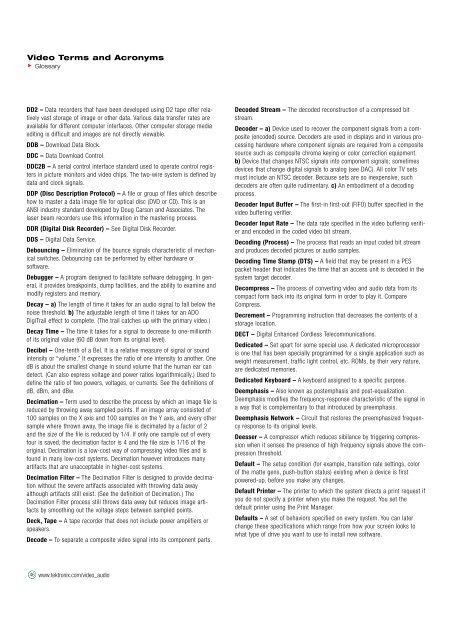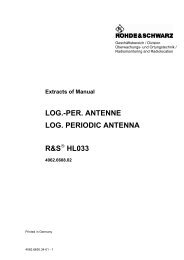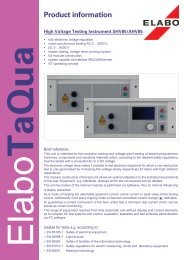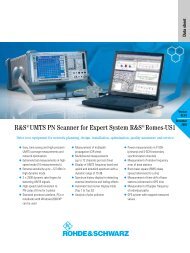Glossary of Video Terms and Acronyms - Isotest
Glossary of Video Terms and Acronyms - Isotest
Glossary of Video Terms and Acronyms - Isotest
Create successful ePaper yourself
Turn your PDF publications into a flip-book with our unique Google optimized e-Paper software.
<strong>Video</strong> <strong>Terms</strong> <strong>and</strong> <strong>Acronyms</strong><br />
<strong>Glossary</strong><br />
DD2 – Data recorders that have been developed using D2 tape <strong>of</strong>fer relatively<br />
vast storage <strong>of</strong> image or other data. Various data transfer rates are<br />
available for different computer interfaces. Other computer storage media<br />
editing is difficult <strong>and</strong> images are not directly viewable.<br />
DDB – Download Data Block.<br />
DDC – Data Download Control.<br />
DDC2B – A serial control interface st<strong>and</strong>ard used to operate control registers<br />
in picture monitors <strong>and</strong> video chips. The two-wire system is defined by<br />
data <strong>and</strong> clock signals.<br />
DDP (Disc Description Protocol) – A file or group <strong>of</strong> files which describe<br />
how to master a data image file for optical disc (DVD or CD). This is an<br />
ANSI industry st<strong>and</strong>ard developed by Doug Carson <strong>and</strong> Associates. The<br />
laser beam recorders use this information in the mastering process.<br />
DDR (Digital Disk Recorder) – See Digital Disk Recorder.<br />
DDS – Digital Data Service.<br />
Debouncing – Elimination <strong>of</strong> the bounce signals characteristic <strong>of</strong> mechanical<br />
switches. Debouncing can be performed by either hardware or<br />
s<strong>of</strong>tware.<br />
Debugger – A program designed to facilitate s<strong>of</strong>tware debugging. In general,<br />
it provides breakpoints, dump facilities, <strong>and</strong> the ability to examine <strong>and</strong><br />
modify registers <strong>and</strong> memory.<br />
Decay – a) The length <strong>of</strong> time it takes for an audio signal to fall below the<br />
noise threshold. b) The adjustable length <strong>of</strong> time it takes for an ADO<br />
DigiTrail effect to complete. (The trail catches up with the primary video.)<br />
Decay Time – The time it takes for a signal to decrease to one-millionth<br />
<strong>of</strong> its original value (60 dB down from its original level).<br />
Decibel – One-tenth <strong>of</strong> a Bel. It is a relative measure <strong>of</strong> signal or sound<br />
intensity or “volume.” It expresses the ratio <strong>of</strong> one intensity to another. One<br />
dB is about the smallest change in sound volume that the human ear can<br />
detect. (Can also express voltage <strong>and</strong> power ratios logarithmically.) Used to<br />
define the ratio <strong>of</strong> two powers, voltages, or currents. See the definitions <strong>of</strong><br />
dB, dBm, <strong>and</strong> dBw.<br />
Decimation – Term used to describe the process by which an image file is<br />
reduced by throwing away sampled points. If an image array consisted <strong>of</strong><br />
100 samples on the X axis <strong>and</strong> 100 samples on the Y axis, <strong>and</strong> every other<br />
sample where thrown away, the image file is decimated by a factor <strong>of</strong> 2<br />
<strong>and</strong> the size <strong>of</strong> the file is reduced by 1/4. If only one sample out <strong>of</strong> every<br />
four is saved, the decimation factor is 4 <strong>and</strong> the file size is 1/16 <strong>of</strong> the<br />
original. Decimation is a low-cost way <strong>of</strong> compressing video files <strong>and</strong> is<br />
found in many low-cost systems. Decimation however introduces many<br />
artifacts that are unacceptable in higher-cost systems.<br />
Decimation Filter – The Decimation Filter is designed to provide decimation<br />
without the severe artifacts associated with throwing data away<br />
although artifacts still exist. (See the definition <strong>of</strong> Decimation.) The<br />
Decimation Filter process still throws data away but reduces image artifacts<br />
by smoothing out the voltage steps between sampled points.<br />
Deck, Tape – A tape recorder that does not include power amplifiers or<br />
speakers.<br />
Decode – To separate a composite video signal into its component parts.<br />
46 www.tektronix.com/video_audio<br />
Decoded Stream – The decoded reconstruction <strong>of</strong> a compressed bit<br />
stream.<br />
Decoder – a) Device used to recover the component signals from a composite<br />
(encoded) source. Decoders are used in displays <strong>and</strong> in various processing<br />
hardware where component signals are required from a composite<br />
source such as composite chroma keying or color correction equipment.<br />
b) Device that changes NTSC signals into component signals; sometimes<br />
devices that change digital signals to analog (see DAC). All color TV sets<br />
must include an NTSC decoder. Because sets are so inexpensive, such<br />
decoders are <strong>of</strong>ten quite rudimentary. c) An embodiment <strong>of</strong> a decoding<br />
process.<br />
Decoder Input Buffer – The first-in first-out (FIFO) buffer specified in the<br />
video buffering verifier.<br />
Decoder Input Rate – The data rate specified in the video buffering verifier<br />
<strong>and</strong> encoded in the coded video bit stream.<br />
Decoding (Process) – The process that reads an input coded bit stream<br />
<strong>and</strong> produces decoded pictures or audio samples.<br />
Decoding Time Stamp (DTS) – A field that may be present in a PES<br />
packet header that indicates the time that an access unit is decoded in the<br />
system target decoder.<br />
Decompress – The process <strong>of</strong> converting video <strong>and</strong> audio data from its<br />
compact form back into its original form in order to play it. Compare<br />
Compress.<br />
Decrement – Programming instruction that decreases the contents <strong>of</strong> a<br />
storage location.<br />
DECT – Digital Enhanced Cordless Telecommunications.<br />
Dedicated – Set apart for some special use. A dedicated microprocessor<br />
is one that has been specially programmed for a single application such as<br />
weight measurement, traffic light control, etc. ROMs, by their very nature,<br />
are dedicated memories.<br />
Dedicated Keyboard – A keyboard assigned to a specific purpose.<br />
Deemphasis – Also known as postemphasis <strong>and</strong> post-equalization.<br />
Deemphasis modifies the frequency-response characteristic <strong>of</strong> the signal in<br />
a way that is complementary to that introduced by preemphasis.<br />
Deemphasis Network – Circuit that restores the preemphasized frequency<br />
response to its original levels.<br />
Deesser – A compressor which reduces sibilance by triggering compression<br />
when it senses the presence <strong>of</strong> high frequency signals above the compression<br />
threshold.<br />
Default – The setup condition (for example, transition rate settings, color<br />
<strong>of</strong> the matte gens, push-button status) existing when a device is first<br />
powered-up, before you make any changes.<br />
Default Printer – The printer to which the system directs a print request if<br />
you do not specify a printer when you make the request. You set the<br />
default printer using the Print Manager.<br />
Defaults – A set <strong>of</strong> behaviors specified on every system. You can later<br />
change these specifications which range from how your screen looks to<br />
what type <strong>of</strong> drive you want to use to install new s<strong>of</strong>tware.





